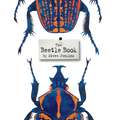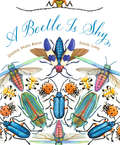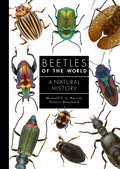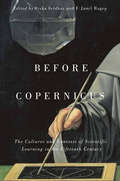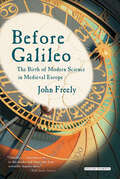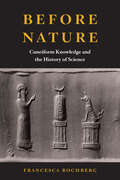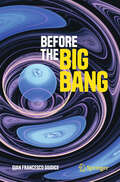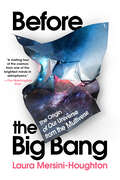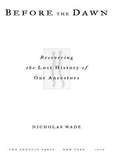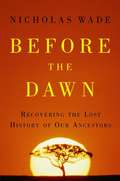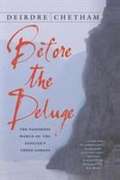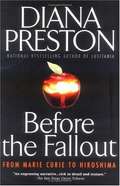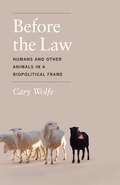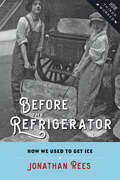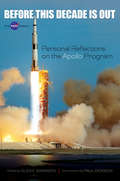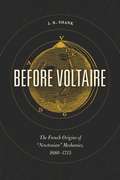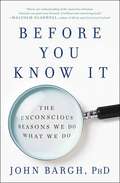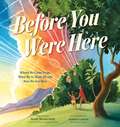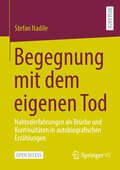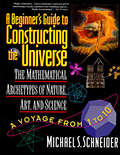- Table View
- List View
The Beetle Book
by Steve JenkinsBeetles squeak and beetles glow. Beetles stink, beetles sprint, beetles walk on water. With legs, antennae, horns, beautiful shells, knobs, and other oddities--what's not to like about beetles? The beetle world is vast: one out of every four living things on earth is a beetle. There are over 350,000 different species named so far and scientists suspect there may be as many as a million. From the goliath beetle that weighs one fourth of a pound to the nine inch long titan beetle, award-winning author-illustrator Steve Jenkins presents a fascinating array of these intriguing insects and the many amazing adaptations they have made to survive.
Beetle Busters: A Rogue Insect And The People Who Track It (Scientists in the Field)
by Loree Griffin BurnsThe Asian longhorned beetle (ALB) has made news across the United States. These beetles came to America from China, living in wood turned into shipping material. At first the beetles invaded urban areas, where hardwood trees were in limited supply—Chicago was able to declare itself ALB-free in 2006. But right now there is bad news in Massachusetts, New York, New Jersey, and Toronto—infestations have erupted in the area&’s hardwood forests, and these beetles, while bad at flying, are very good at killing trees.Clint McFarland&’s job? Stop the ALB at any cost. How do you balance the needs of residents, the impact to the environment, and an invasive species primed to wipe out entire forests? It takes the help of everyday people, such as children playing baseball at a playground, teams of beetle-sniffing dogs, and science-minded people (bug scientists and tree doctors) to eradicate this invasive pest.
A Beetle Is Shy
by Dianna Hutts AstonThe award-winning duo of Dianna Hutts Aston and Sylvia Long team up again, this time creating a gorgeous look at the fascinating world of beetles. From flea beetles to bombardier beetles, an incredible variety of these beloved bugs are showcased here in all their splendor. Poetic in voice and elegant in design, this carefully researched and visually striking book is perfect for sparking children's imaginations in both classroom reading circles and home libraries. Plus, this is the fixed-format version, which looks almost identical to the print edition!
Beetles of the World: A Natural History (A Guide to Every Family #7)
by Maxwell V. Barclay Patrice BouchardA richly illustrated guide to the astonishing variety of beetles around the worldBeetles make up about a quarter of known animal species and are arguably the most diverse group of organisms on Earth: almost 400,000 species have been formally described so far, and it is likely that this number merely scratches the surface. In Beetles of the World, Maxwell Barclay and Patrice Bouchard—two of the world’s foremost beetle experts—celebrate these remarkable creatures in all their variety, from their size and appearance to their ecological importance.Providing concise accounts of all the major families and subfamilies of Coleoptera, Beetles of the World explores beetle anatomy, life cycle, fossil history, feeding habits, role in the food web, habitats, relationship with humans, and classification—as well as the essential part that beetles play in the global ecosystem, and the ways humans can help protect them.Features 300 stunning color photographsPresents family profiles with a distribution map, table of information, and commentaryIncludes a comprehensive introduction that provides insight into the astonishing diversity of beetles and their histories
Before Civilization: The Radiocarbon Revolution and Prehistoric Europe
by Colin RenfrewMonuments in Central and Western Europe have proved to be older than their supposed Near-Eastern forerunners, and the record must be almost completely rewritten in the light of these new dates. Before Civilization is an attempt to do this with the help of analogies from more recent and well-documented primitive societies.
Before Copernicus: The Cultures and Contexts of Scientific Learning in the Fifteenth Century (McGill-Queen's Studies in the History of Ideas)
by F. Jamil Ragep Rivka FeldhayIn 1984, Noel Swerdlow and Otto Neugebauer argued that Nicolaus Copernicus (1473–1543) explained planetary motion by using mathematical devices and astronomical models originally developed by Islamic astronomers in the thirteenth and fourteenth centuries. Was this a parallel development, or did Copernicus somehow learn of the work of his predecessors, and if so, how? And if Copernicus did use material from the Islamic world, how then should we understand the European context of his innovative cosmology? Although Copernicus’s work has been subject to a number of excellent studies, there has been little attention paid to the sources and diverse cultures that might have inspired him. Foregrounding the importance of interactions between Islamic and European astronomers and philosophers, Before Copernicus explores the multi-cultural, multi-religious, and multi-lingual context of learning on the eve of the Copernican revolution, determining the relationship between Copernicus and his predecessors. Essays by Christopher Celenza and Nancy Bisaha delve into the European cultural and intellectual contexts of the fifteenth century, revealing both the profound differences between “them” and “us,” and the nascent attitudes that would mark the turn to modernity. Michael Shank, F. Jamil Ragep, Sally Ragep, and Robert Morrison depict the vibrant and creative work of astronomers in the Christian, Islamic, and Jewish worlds. In other essays, Rivka Feldhay, Raz Chen-Morris, and Edith Sylla demonstrate the importance of shifting outlooks that were critical for the emergence of a new worldview. Highlighting the often-neglected intercultural exchange between Islam and early modern Europe, Before Copernicus reimagines the scientific revolution in a global context.
Before Galileo: The Birth of Modern Science in Medieval Europe
by John FreelyA physicist and historian sheds light on scientific minds, breakthroughs, and innovations that paved the way for the Scientific Revolution.Histories of modern science often begin with the heroic battle between Galileo and the Catholic Church, a conflict which ignited the Scientific Revolution and led to the world-changing discoveries of Isaac Newton. As a consequence of this narrative frame, virtually nothing is said about the European scholars who came before. In reality, more than a millennium before the Renaissance, a succession of scholars paved the way for the exciting discoveries usually credited to Galileo, Newton, Copernicus, and others. In Before Galileo, John Freely examines the pioneering research of the first European scientists, many of them monks whose influence ranged far beyond the walls of the monasteries where they studied and wrote.
Before It's Gone: Stories from the Front Lines of Climate Change in Small-Town America
by Jonathan VigliottiFrom CBS News national correspondent Jonathan Vigliotti, a &“vivid&” (Elizabeth Kolbert, Pulitzer Prize–winning author) and &“stunning&” (Booklist) character-driven call to action on our climate, told through the stories of the pioneering Americans working to persevere as leadership inaction risks the very survival of our heartland and hometowns.Discussion of the climate crisis has always suffered from a problem of abstraction. Data points and warnings of an overheated future struggle to break through the noise of everyday life. Deniers often portray climate solutions as inconvenient, expensive, and unnecessary. And many politicians, cloistered by status and focused always on their next election, do not yet see climate as a winning issue in the short run, so they don&’t take any action at all. But climate change, and its devastating consequences, has kept apace whether we want to pay attention or not. CBS News national correspondent Jonathan Vigliotti has seen that crisis unfold for himself, spending nearly two decades reporting across the United States (and the world) documenting the people, communities, landmarks, and traditions we&’ve already surrendered. Vigliotti shares with urgency and personal touch the story of an America on the brink. Before It&’s Gone traces Vigliotti&’s travels across the country, taking him to the frontlines of climate disaster and revealing the genuine impacts of climate change that countless Americans have already been forced to confront. From massive forest fires in California to hurricanes in Louisiana, receding coastlines in Massachusetts and devastated fisheries in Alaska, we learn that warnings of a future impacted by climate are no more; the climate catastrophe is already here. This is the story of America, and Americans, on the edge, and a powerful argument that radical action on climate change with a respect for its people and traditions is not only possible, but also the only way to preserve what we love.
Before Nature: Cuneiform Knowledge and the History of Science
by Francesca RochbergIn the modern West, we take for granted that what we call the “natural world” confronts us all and always has—but Before Nature explores that almost unimaginable time when there was no such conception of “nature”—no word, reference, or sense for it. Before the concept of nature formed over the long history of European philosophy and science, our ancestors in ancient Assyria and Babylonia developed an inquiry into the world in a way that is kindred to our modern science. With Before Nature, Francesca Rochberg explores that Assyro-Babylonian knowledge tradition and shows how it relates to the entire history of science. From a modern, Western perspective, a world not conceived somehow within the framework of physical nature is difficult—if not impossible—to imagine. Yet, as Rochberg lays out, ancient investigations of regularity and irregularity, norms and anomalies clearly established an axis of knowledge between the knower and an intelligible, ordered world. Rochberg is the first scholar to make a case for how exactly we can understand cuneiform knowledge, observation, prediction, and explanation in relation to science—without recourse to later ideas of nature. Systematically examining the whole of Mesopotamian science with a distinctive historical and methodological approach, Before Nature will open up surprising new pathways for studying the history of science.
Before the Big Bang: The Prehistory of Our Universe
by Brian CleggAccording to a recent survey, the most popular question about science from the general public was: what came before the Big Bang? We all know on some level what the Big Bang is, but we don't know how it became the accepted theory, or how we might know what came before. In Before the Big Bang, Brian Clegg (the critically acclaimed author of Upgrade Me and The God Effect) explores the history of this remarkable concept. From the earliest creation myths, through Hershel's realization that the Milky Way was one of many galaxies, to on-going debates about Black Holes, this is an incredible look at the origins of the universe and the many theories that led to the acceptance of the Big Bang. But in classic scientist fashion Clegg challenges the notion of the "Big Bang" itself, and raises the deep philosophical question of why we might want to rethink the origin of the universe. This is popular science at its best, exploratory, controversial, and utterly engrossing.
Before the Big Bang (Copernicus Books)
by Gian Francesco GiudiceA theoretical physicist returns by train from a conference, his eyes fixed on a paper on quantum cosmology. Suddenly, a little girl's voice interrupts his musings. "What are you reading?" "It's the story of the universe." "If it tells the whole story of the universe, does it say anything about me?" Starting from this question, this book explores our current understanding of the Big Bang, the primordial event that gave rise to the special mixture of space, time, and matter that we call the universe. It is a journey through cosmic history, pushing the limits of human knowledge, winding its way through general relativity, curved spaces, quantum mechanics and the multiverse. Giudice succeeds in uniting science and the history of thought, tracing the debate that animated the physics community, when faced with the hypothesis and then the confirmation of the Big Bang. This book recounts the great discoveries in cosmology and leads us to the frontiers of current scientific research. It is a fascinating and thought-provoking parable that addresses complex concepts with the fluidity of storytelling and allows us to better understand the universe around us. “A fascinating, enchanting narrative. A fairy tale that tells a true story spanning 13.8 billion years. Exciting from the first to the last page.” Fabiola Gianotti, CERN Director General “In this beautiful book, of exemplary clarity, Giudice guides us by the hand through the history and mysteries of the Big Bang.” Giorgio Parisi, 2021 Nobel Prize in Physics
Before the Big Bang: The Origin of the Universe and What Lies Beyond
by Laura Mersini-HoughtonA revolutionary new account of our universe’s creation—and a breathtaking exploration of the landscape from which we sprang—from one of the world’s most celebrated cosmologistsWhat came before the Big Bang, and what exists outside of the universe it created? Until recently, scientists could only guess at what lay past the edge of space-time. However, as pioneering theoretical physicist Laura Mersini-Houghton explains, new scientific tools are now giving us the ability to peer beyond the limits of our universe and to test our theories about what is there. And what we are finding is upending everything we thought we knew about the cosmos and our place in it.Mersini-Houghton is no stranger to boundaries—or to pushing through them. As a child growing up in Communist Albania, she discovered a universe beyond her walled-off world through the study of math and science, and through music. As a female cosmologist in a male-dominated field, she transcended the limits that society and her profession tried to place on her. And as a trailblazing researcher, she helped to revolutionize the study of our universe by revealing that, far from living in a cosmic Albania, with a world that ends at its borders, we are part of a larger family of universes—a multiverse—that holds wonders we are only beginning to unlock. Mersini-Houghton’s groundbreaking research suggests that we sit in a quantum landscape whose peaks and valleys hide a multitude of other universes, and even hold the secret to the origins of existence itself. Recent evidence has revealed the signatures of such sibling universes in our own night sky, confirming Mersini-Houghton’s theoretical work and offering humbling evidence that our universe is just one member of an unending cosmic family.The incredible scientific saga of one woman’s mind-expanding journey through the multiverse, Before the Big Bang will reshape our understanding of humanity’s place in the unfathomable vastness of the cosmos.
Before the Collapse: A Guide to the Other Side of Growth
by Ugo BardiNobody has to tell you that when things go bad, they go bad quickly and seemingly in bunches. Complicated structures like buildings or bridges are slow and laborious to build but, with a design flaw or enough explosive energy, take only seconds to collapse. This fate can befall a company, the stock market, or your house or town after a natural disaster, and the metaphor extends to economies, governments, and even whole societies. As we proceed blindly and incrementally in one direction or another, collapse often takes us by surprise. We step over what you will come to know as a “Seneca cliff”, which is named after the ancient Roman philosopher, Lucius Annaeus Seneca, who was the first to observe the ubiquitous truth that growth is slow but ruin is rapid. Modern science, like ancient philosophy, tell us that collapse is not a bug; it is a feature of the universe. Understanding this reality will help you to see and navigate the Seneca cliffs of life, or what Malcolm Gladwell called “tipping points.” Efforts to stave off collapse often mean that the cliff will be even steeper when you step over it. But the good news is that what looks to you like a collapse may be nothing more than the passage to a new condition that is better than the old.This book gives deeper meaning to familiar adages such as “it’s a house of cards”, “let nature take its course”, “reach a tipping point”, or the popular Silicon Valley expression, “fail fast, fail often.” As the old Roman philosopher noted, “nothing that exists today is not the result of a past collapse”, and this is the basis of what we call “The Seneca Strategy.” This engaging and insightful book will help you to use the Seneca Strategy to face failure and collapse at all scales, to understand why change may be inevitable, and to navigate the swirl of events that frequently threaten your balance and happiness. You will learn:How ancient philosophy and modern science agree that failure and collapse are normal features of the universePrinciples that help us manage, rather than be managed by, the biggest challenges of our lives and times Why technological progress may not prevent economic or societal collapseWhy the best strategy to oppose failure is not to resist at all costsHow you can “rebound” after collapse, to do better than before, and to avoid the same mistakes.
Before the Dawn: Recovering the Lost History of Our Ancestors
by Nicholas WadeNicholas Wade's articles are a major reason why the science section has become the most popular, nationwide, in the New York Times. In his groundbreaking Before the Dawn, Wade reveals humanity's origins as never before-a journey made possible only recently by genetic science, whose incredible findings have answered such questions as: What was the first human language like? How large were the first societies, and how warlike were they? When did our ancestors first leave Africa, and by what route did they leave? By eloquently solving these and numerous other mysteries, Wade offers nothing less than a uniquely complete retelling of a story that began 500 centuries ago.
Before the Dawn: Recovering The Lost History of Our Ancestors
by Nicholas WadeWritten by a New York Times science reporter in language that is readable and comprehensible, for the most part, to the lay person, this book explains evolution in terms of genetics "The narrative of the human genome explains our origins, our history, and our nature...At its most basic, the process of evolution is simply a change in gene frequencies between generations; one version of a gene, in other words, becomes more common in a population and other versions less common..." there are quite a few symbols that are parts of names. All junk characters have been eliminated. All characters present that may appear to be junk are part of the book. The notes, bibliography and index have not been validated. I think they are comprehensible and usable; if you need them to be fixed, let me know and I will get the book and validate them. Cindy R popularplace@yahoo.com
Before the Deluge: The Vanishing World of the Yangtze's Three Gorges
by Deirdre ChethamChetham's elegiac book about the towns along the banks of the Three Gorges area of the Yangtze River was written on the very eve of their destruction. After great controversy, the Chinese government has begun construction of the world's largest hydroelectric dam in the Three Gorges section of the Yangtze, a place renowned for its beauty. For over two thousand years, the Yangtze has been the great transport route linking the coast with the west and southwest and providing irrigation for thefarms that fed China. Once the dam is completed in 2009, the water level will rise as much as 350 feet in a hundred-mile stretch of the river. The water will submerge over a dozen large cities, almost 1,500 villages and towns, and innumerable historical and cultural sites. Over a million people are being moved, voluntarily or otherwise, altering not only their lives, but the lives of a multitude of others whose existence is intertwined with the river. Before the Deluge captures a sense of the daily life, traditions and history of the people who live along the Upper Yangtze's Three Gorges area. It chronicles the region's past and present with an eye on the disruption of an existing way of life. Perhaps most importantly, it captures a world that is rapidly vanishing under the rushing waters of one of the world's largest rivers.
Before the Fallout: From Marie Curie to Hiroshima
by Diana PrestonPreston describes the development of nuclear weapons, beginning with Marie Curie's work with radioactivity at the turn of the twentieth century and discussing the advances of subsequent scientists like Rutherford, Bohr, Einstein, and Oppenheimer. She traces how scientific discoveries were transformed into the atomic weapon first used on Hiroshima. Preston is the author of other books, including Lusitania: An Epic Tragedy.
Before the Law: Humans and other Animals in a Biopolitical Frame
by Cary WolfeAnimal studies and biopolitics are two of the most dynamic areas of interdisciplinary scholarship, but until now, they have had little to say to each other. Bringing these two emergent areas of thought into direct conversation in Before the Law, Cary Wolfe fosters a new discussion about the status of nonhuman animals and the shared plight of humans and animals under biopolitics. Wolfe argues that the human-animal distinction must be supplemented with the central distinction of biopolitics: the difference between those animals that are members of a community and those that are deemed killable but not murderable. From this understanding, we can begin to make sense of the fact that this distinction prevails within both the human and animal domains and address such difficult issues as why we afford some animals unprecedented levels of care and recognition while subjecting others to unparalleled forms of brutality and exploitation. Engaging with many major figures in biopolitical thought--from Heidegger, Arendt, and Foucault to Agamben, Esposito, and Derrida--Wolfe explores how biopolitics can help us understand both the ethical and political dimensions of the current questions surrounding the rights of animals.
Before the Refrigerator: How We Used to Get Ice (How Things Worked)
by Jonathan ReesHow increased access to ice—decades before refrigeration—transformed American life.During the late nineteenth and early twentieth centuries, Americans depended upon ice to stay cool and to keep their perishable foods fresh. Jonathan Rees tells the fascinating story of how people got ice before mechanical refrigeration came to the household. Drawing on newspapers, trade journals, and household advice books, Before the Refrigerator explains how Americans built a complex system to harvest, store, and transport ice to everyone who wanted it, even the very poor.Rees traces the evolution of the natural ice industry from its mechanization in the 1880s through its gradual collapse, which started after World War I. Meatpackers began experimenting with ice refrigeration to ship their products as early as the 1860s. Starting around 1890, large, bulky ice machines the size of small houses appeared on the scene, becoming an important source for the American ice supply. As ice machines shrunk, more people had access to better ice for a wide variety of purposes. By the early twentieth century, Rees writes, ice had become an essential tool for preserving perishable foods of all kinds, transforming what most people ate and drank every day. Reviewing all the inventions that made the ice industry possible and the way they worked together to prevent ice from melting, Rees demonstrates how technological systems can operate without a central controlling force. Before the Refrigerator is ideal for history of technology classes, food studies classes, or anyone interested in what daily life in the United States was like between 1880 and 1930.
Before This Decade Is Out
by Paul Dickson Glen SwansonThese oral histories by major participants in the Apollo program relive the events that culminated in the 1969 moon landing. Recollections of 14 participants include comments by NASA administrators James Webb and Thomas O. Paine; Wernher von Braun, architect of the Saturn V rocket; and astronauts Harrison Schmitt and Charles Duke. 69 black-and-white illustrations.
Before Voltaire: The French Origins of “Newtonian” Mechanics, 1680–1715
by J.B. ShankWe have grown accustomed to the idea that scientific theories are embedded in their place and time. But in the case of the development of mathematical physics in eighteenth-century France, the relationship was extremely close. In Before Voltaire, J.B. Shank shows that although the publication of Isaac Newton’s Principia in 1687 exerted strong influence, the development of calculus-based physics is better understood as an outcome that grew from French culture in general. Before Voltaire explores how Newton’s ideas made their way not just through the realm of French science, but into the larger world of society and culture of which Principia was an intertwined part. Shank also details a history of the beginnings of calculus-based mathematical physics that integrates it into the larger intellectual currents in France at the time, including the Battle of the Ancients and the Moderns, the emergence of wider audiences for science, and the role of the newly reorganized Royal Academy of Sciences. The resulting book offers an unprecedented cultural history of one the most important and influential elements of Enlightenment science.
Before You Know It: The Unconscious Reasons We Do What We Do
by John BarghDr. John Bargh, the world’s leading expert on the unconscious mind, presents a groundbreaking book, twenty years in the making, which gives us an entirely new understanding of the hidden mental processes that secretly govern every aspect of our behavior.For more than three decades, Dr. John Bargh has been responsible for the revolutionary research into the unconscious mind, research that informed bestsellers like Blink and Thinking Fast and Slow. Now, in what Dr. John Gottman said “will be the most important and exciting book in psychology that has been written in the past twenty years,” Dr. Bargh takes us on an entertaining and enlightening tour of the forces that affect everyday behavior while transforming our understanding of ourselves in profound ways. Telling personal anecdotes with infectious enthusiasm and disclosing startling and delightful discoveries, Dr. Bargh takes the reader into his labs at New York University and Yale where he and his colleagues have discovered how the unconscious guides our behavior, goals, and motivations in areas like race relations, parenting, business, consumer behavior, and addiction. He reveals what science now knows about the pervasive influence of the unconscious mind in who we choose to date or vote for, what we buy, where we live, how we perform on tests and in job interviews, and much more. Because the unconscious works in ways we are completely unaware of, Before You Know It is full of surprising and entertaining revelations as well as tricks to help you remember to-do items, shop smarter, and sleep better. Destined to be a bestseller, Before You Know It is an intimate introduction to a fabulous world only recently discovered, the world that exists below the surface of your awareness and yet is the key to knowing yourself and unlocking new ways of thinking, feeling, and behaving.
Before You Were Here: Where We Come From, What We're Made Of, and How We Got Here
by Scott WesterfeldDive into a vibrant celebration of our connection to the natural world in this stunning picture book perfect for fans of Matt de la Peña and Loren Long's LOVE and Jason Chin's THE UNIVERSE IN YOU.Before you were here, you were everywhere...You were once the sunshine when it struck the trees. You were water, powerful enough to wear away mountains. You were soil deep beneath the earth.Now that you’re here, the world waits for you.Everywhere.Follow a young child as he explores the world around him and begins to understand that he is connected to all things -- sunshine which nourishes us, water which makes up most of our bodies, and soil which contains minerals that keep us strong and healthy.Blending a tale of new life with real science, this picture book by New York Times bestselling author of the Uglies series Scott Westerfeld and illustrated by Sibert Honor-winning Jessica Lanan is a sweeping ode to a parent's love for their child, budding life, and the Earth that we live on. *Includes robust backmatter that expands on the ways the natural world lives in our bodies.
Begegnung mit dem eigenen Tod: Nahtoderfahrungen als Brüche und Kontinuitäten in autobiografischen Erzählungen
by Stefan NadileIn diesem Open-Access-Buch wird die Nahtoderfahrung (NTE) als Phänomen im Kontext der Erforschung des Todes, daraus abgeleitete Todesdefinitionen und ihr Wandel vor dem Hintergrund historischer Entwicklungen und ihren gesellschaftlichen Trends beleuchtet. Mit dem Bekanntwerden des Phänomens können in Bezug auf die Aussagekraft von NTE verschiedene Deutungen identifiziert werden, die sich zum Teil mit dem Aufkommen neureligiöser Bewegungen institutionalisieren. Darauf folgt eine Hinwendung zu individuellen Innensichten auf die NTE und ihrer Kommunizierbarkeit. Die kommunikative Erörterung solcher Ereignisse gilt als Gegenstand der Darstellung eines außergewöhnlichen Ereignisses in der autobiografischen Erzählung. Die Argumentationslinie einerseits und die Topologie der Deutungsebenen andererseits bilden die Grundlage für die Analyse der Studienergebnisse. Als Datengrundlage dienen eigens für diese Arbeit erhobene biografisch-narrative Interviews. Deren Analyse resultiert in einer Typisierung, wie NTE im autobiografischen Kontext gedeutet werden, welche sozialen Deutungsmuster dabei implizit zum Tragen kommen und wie die Person von ihrer Biografie erzählt. Jeder Typus steht je für eine Grundhaltung zur Lebenswelt und je für eine Strategie zur Integration der Erfahrung in das eigene Leben.
A Beginner's Guide to Constructing the Universe: The Mathematical Archetypes of Nature, Art, and Science
by Michael S. SchneiderDiscover how mathematical sequences abound in our natural world in this definitive exploration of the geography of the cosmosYou need not be a philosopher or a botanist, and certainly not a mathematician, to enjoy the bounty of the world around us. But is there some sort of order, a pattern, to the things that we see in the sky, on the ground, at the beach? In A Beginner's Guide to Constructing the Universe, Michael Schneider, an education writer and computer consultant, combines science, philosophy, art, and common sense to reaffirm what the ancients observed: that a consistent language of geometric design underpins every level of the universe, from atoms to galaxies, cucumbers to cathedrals. Schneider also discusses numerical and geometric symbolism through the ages, and concepts such as periodic renewal and resonance. This book is an education in the world and everything we can't see within it.Contains numerous b&w photos and illustrations.
